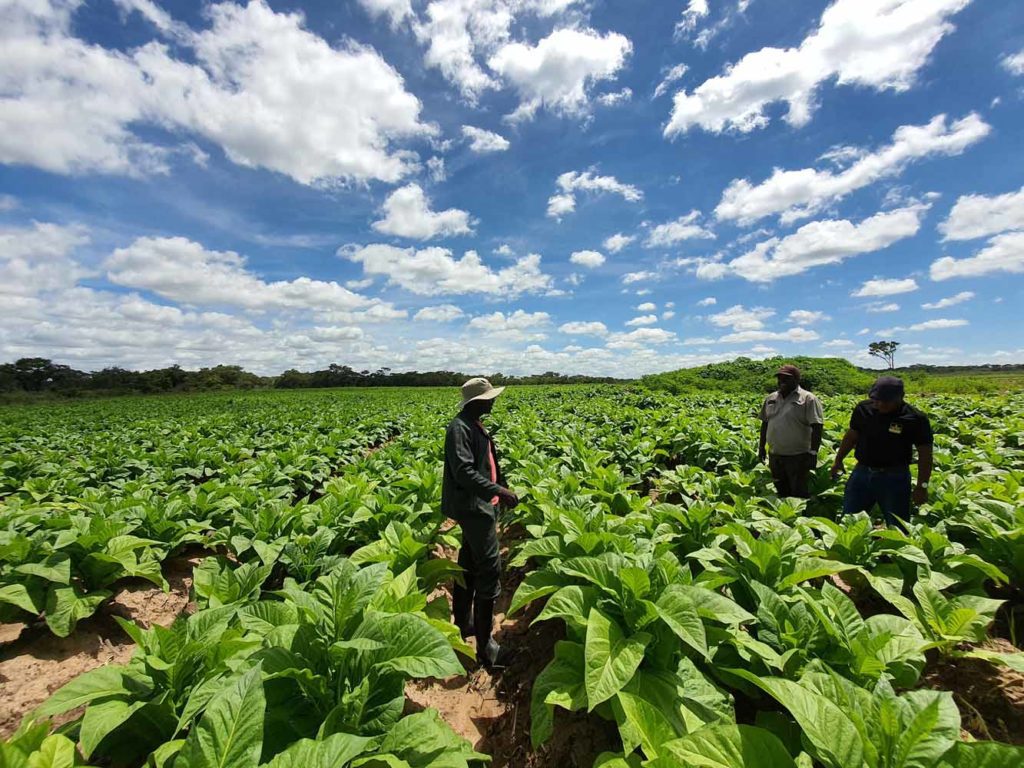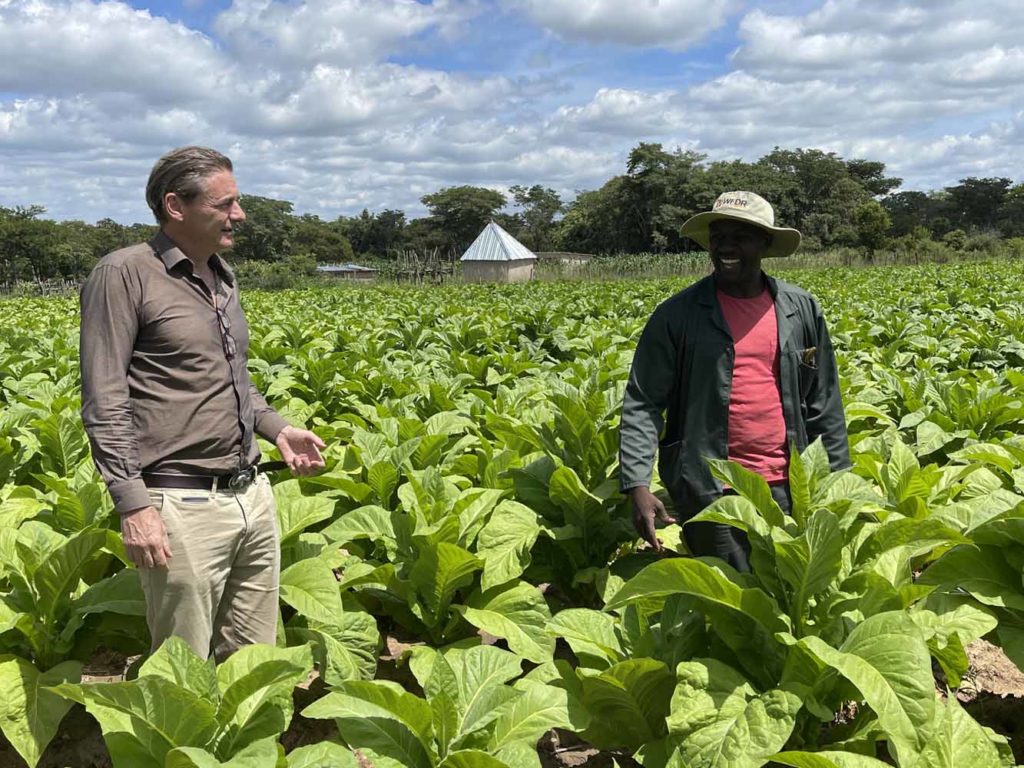Great Expectations
- Also in TR Leaf Print Edition Special Report
- May 1, 2022
- 0
- 11 minutes read


Cavendish Lloyd has started growing low-nicotine flue-cured tobacco in Zimbabwe for shisha.
By George Gay
Although it’s unfashionable to say so, I believe there is something most appealing about some aspects of tobacco and the tobacco business, not least because they are naturally part of the Slow Movement. Indeed, they were part of that movement long before it came into existence in the mid-1980s with the realization that there was something to be gained in taking the time to savor certain things—and something being lost in doing things too quickly.
For instance, though many welcome efficiencies have been introduced to the leaf tobacco business over the years, it always had about it, and still has, a comfortingly unhurried air. I mean, there is, after all, no point in a farmer, at the start of the growing season, standing over her seedlings and shouting, “ready, steady, grow!” And who in their right mind would want to walk quickly through a tobacco warehouse when he could dawdle and savor the aroma?
Of course, not all aspects of the tobacco business are slow, nor should they be. There is a lot to be said for introducing the sorts of machinery updates and general processing efficiencies and manufacturing efficiencies covered in another story in this issue (see “The Virtuous Loop,” page 36). But, at the same time, there are other aspects of the business that have contraventions of the tenets of the Slow Movement that are to its detriment. I find it sad, for instance, to see smokers racing through their cigarettes as they stand in the cold outside pubs and offices.

Unseen Advantage
Luckily, however, there is a type of smoking that still lends itself to savoring the moment, which comprises mainly the enjoyment of products such as fine cigars, pipes and shisha. Shisha smoking, especially, tends to be part of a relaxed social occasion, and perhaps that is why its appeal is increasing at a time when that of other combustible tobacco products is not.
And that increase in appeal is occurring, I suspect, without too many shisha smokers realizing there is an unseen advantage in their choice of product, the tobacco component of which could have been grown in a more environmentally friendly way than that of many other tobaccos. Indeed, I, too, didn’t know of this potential environmental advantage until I corresponded recently on the subject of low-nicotine Virginia flue-cured tobacco (LNFCT) with Koen Monkau, the president of Cavendish Lloyd, and Frank Magama, the head of the Plant Breeding Division of the Tobacco Research Board’s (TRB) Kutsaga Research Station in Harare, Zimbabwe.
Monkau told me his company was experimenting in Zimbabwe with growing LNFCT for use in shisha products, and I assumed the aim of using such tobacco was to try to wean people off smoking as is being attempted in the U.S. in the case of cigarettes. But Monkau explained that, in general, shisha manufacturers required LNFCT (less than 1 percent nicotine) mainly because of its physical characteristics. This style of leaf was pale, white-yellow and very thin, he said, and it had the propensity to absorb the high levels of molasses and flavors that needed to be added to it.
But this style of leaf also has a number of advantages when it comes to the environment and the cost of producing it, partly because it is closer grown than is standard flue-cured tobacco and partly because of a major reduction in the need for chemical applications. Magama told me it was expected that LNFCT would have lower costs of production with significant savings being made from reductions in the use of fertilizer and the cutting out altogether of systemic and contact suckercide applications. Labor savings would be made because topping would not be required, something that normally involved making several rounds of a crop. And energy and time savings would be made on curing the resultant thinner and smaller leaves.

Growing Trials
Cavendish Lloyd was established in 2011 by Monkau, who has been involved in tobacco for more than 25 years, and his wife, Jiayu Wang, who is vice president of the company. The company’s largest operation in respect of staff numbers is to be found in Zimbabwe, but it operates in the Far East, the Middle East and Europe as well as in other parts of Africa. Overall, it has about 100 employees. It is active throughout the tobacco chain, from the growing of tobacco to the marketing and distribution of cigarettes, though, currently, it does not directly operate any leaf processing or tobacco manufacturing facilities—or, I should point out, offer Cavendish tobacco. It is the exclusive distributor of KT&G products in Zimbabwe.
Given the company’s close association with Zimbabwe, and the country’s favorable climatic and soil conditions, it is not surprising that this is where Monkau is currently conducting, in conjunction with Magama’s team, LNFCT growing trials and where he intends to expand into larger scale production during the next season, which will run from later this year into next year. And it is not surprising, either, that Magama shares this enthusiasm for Zimbabwe. He told me in an email exchange that he believed there was a combination of factors that made Zimbabwe a suitable country for growing LNFCT, including its resilient grower base, the presence of supportive merchants, a long tradition of growing the crop, and soils that were inherently low in nitrogen, which allowed growers to have good control of plant nutrition when producing LNFCT.
Asked whether LNFCT varieties were more or less difficult to grow than traditional varieties, Magama said that both required the same attention to detail and good management, though, in the case of LNFCT, some key agronomic practices had to be modified, owing, for example, to the previously mentioned need for less fertilizer and the absence of topping. He added that there was so far no clear evidence about whether it was better to grow LNFCT in the dry lands or as irrigated crops, but he said it was important to note that excessive irrigation or precipitation limited growth and nicotine accumulation through leaching of nitrogen while excessively dry conditions resulted in high nicotine accumulation. Much of the year-to-year variation in nicotine content in a variety was due to differences in rainfall, with everything else being equal.
At the time of writing, Cavendish Lloyd was in the process of grading its first trial crop of LNFCT, which was grown during the 2021–2022 season by a farmer operating near Marondera, Mashonaland East, and with the help of the Kutsaga team. But it has ambitions to quickly increase its production of LNFCT in Zimbabwe, and it aims, eventually, to become a major player in LNFCT by expanding production into Zambia, Malawi and South Africa.

Exponential Growth
Monkau believes that central and southern Africa can provide significant volumes of LNFCT at competitive prices. And, importantly, having done his research, he believes there is a ready market for such tobaccos. “Within the tobacco market at large, there are some segments that are in decline or stable and other segments that are growing fast,” he told me in an email exchange. “The shisha market is definitely in the last category, with even exponential growth expected in the next few years.”
Given such opportunities come to fruition, it seems likely that other players will be attracted to growing LNFCT in Zimbabwe, a fact Monkau hinted at when he made the point that establishing an LNFCT production industry in Zimbabwe would be an important step in helping to expand and diversify the country’s tobacco client portfolio.
Currently, no other companies are growing low-nicotine varieties in Zimbabwe or taking part in production trials. However, it seems that interest is growing. Magama told me the TRB had been involved with low-nicotine trials for the past five years, working with many merchants with different objectives and end-use applications. And the board had been selected, he said, to be part of a three-year global study on low-nicotine tobacco being coordinated by a taskforce of the Cooperation Centre for Scientific Research Relative to Tobacco.
The plant breeding division of the TRB plays a vital role in low-nicotine trials, conducting research and making available where appropriate the results of that research. The division also makes recommendations when called upon to do so by the Tobacco Industry and Marketing Board (TIMB) and other stakeholders. Again, such cooperation is vital because the TIMB is responsible for authorizing the growing in Zimbabwe of any tobacco variety, and it is the TRB that carries out value for cultivation and use studies, and, on the basis of those studies, recommends or not the variety in question.
Furthermore, two other government departments, the Seed Services Institute and the Plant Quarantine Services Institute, are involved in ensuring only suitable varieties are grown by processing seed permits and ensuring all phytosanitary issues from the country of origin are addressed before seed importation is made.
It might seem from the above that obtaining permission for experimenting with new varieties would be complex, but, for instance, authorization for the seed used for Cavendish Lloyd’s trials was processed for the company by the TRB.
The seed in question was obtained from a company based in Europe that has long cooperated with Zimbabwe and is a stable source of supply. But, in any case, Magama said that, depending on the results of the trial, it was possible seed could be sourced elsewhere if it were necessary to address limitations the original seed might have. Further, local breeding efforts could be activated should there be a business case for this nascent tobacco type, he added.
Finally, without wishing to interrupt the Slow Movement that inevitably controls the scheduling of research and trials, I need to point out that Monkau intends to introduce some allegro con brio into his enterprise. “We plan to grow 1 million kg green from season 2022–2023,” he said. “This might seem ambitious, but we have spent a lot of time on research and are confident we can make it.”

